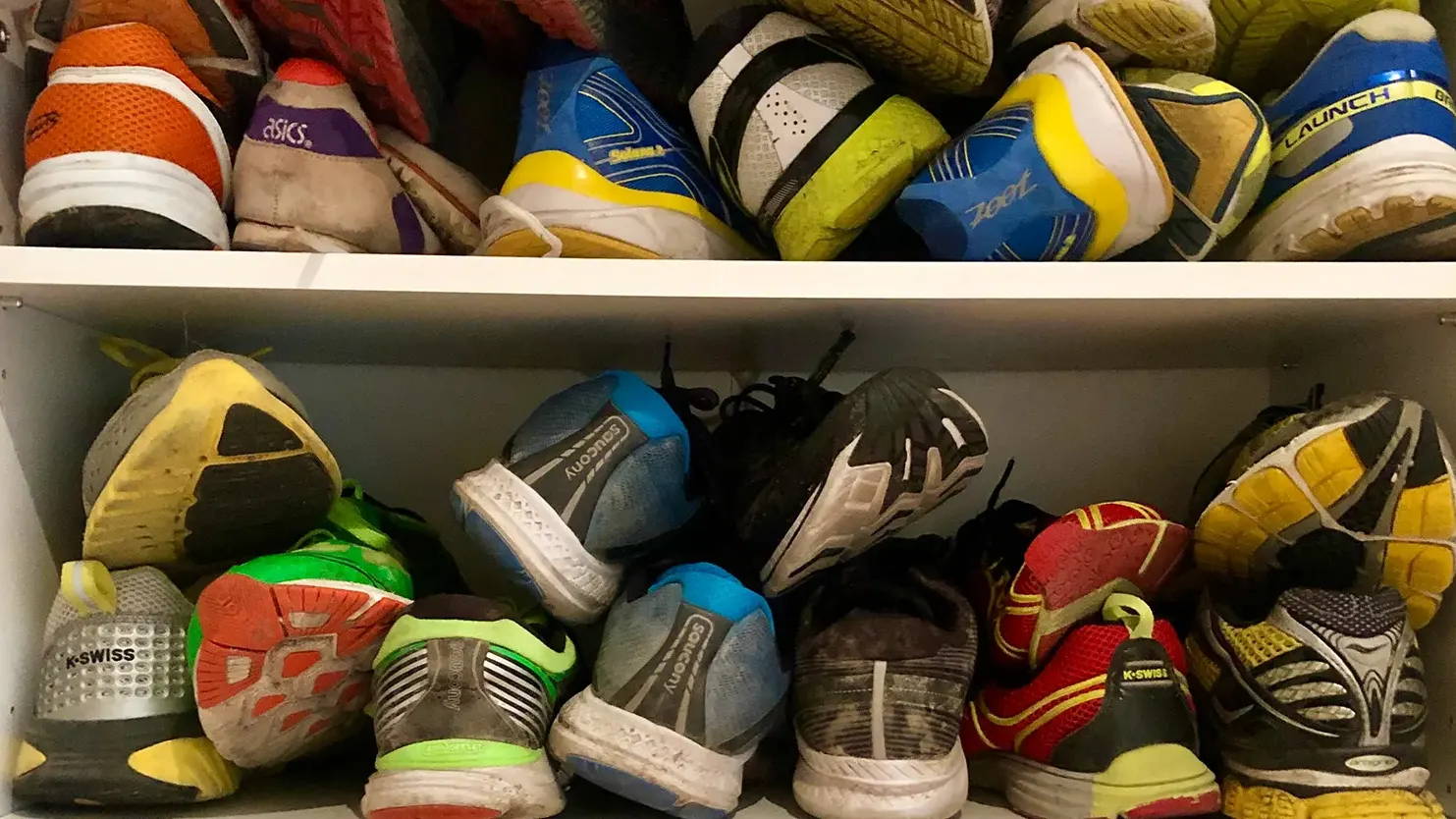Eine Faustregel besagt: die Anzahl der Laufschuhe in Deinem Schuhschrank sollte der Anzahl der Laufeinheiten entsprechen, die Du pro Woche absolviert. Tatsächlich ist diese Regel sehr sinnvoll. Warum Du läuferisch von einer größeren Vielfalt an Schuhen profitierst und wie verschiedene Laufschuhe die Qualität Deiner Trainingseinheiten erhöhen können, liest Du in folgendem Beitrag.
Die Abwechslung macht's
Läufst Du jede Trainingseinheit immer mit den gleichen Schuhen? Dann gibt es gute Gründe, Deine Auswahl zu erweitern:
- Aktivierung der Fußmuskulatur, Verringerung der Verletzungsanfälligkeit
Läufst Du immer in denselben Schuhen, passt sich Deine Fuß- und Bewegungsmuskulatur im Lauf der Zeit an diesen einen Schuh und seine Eigenschaften (Dämpfung, Sohle, Abrollverhalten, etc.) an. Die Aktivierung der körpereigenen Dämpfungs- und Stabilisierungssysteme (Muskel-, Sehnen-, Bänderapparat) nimmt zunehmend ab, da diese durch den Schuh ersetzt wird. Unterschiedliche Schuhe hingegen - vor allem mit unterschiedlichen Laufkonzepten - setzen für die Fußmuskulatur neue Reize und kräftigen sie dadurch. Ein anpassungsfähiges muskuläres System kann unterschiedliche Belastungen besser tolerieren und ist weniger verletzungsanfällig.
- Verbesserung der Lauftechnik
Gerade die verschiedenen Ansätze in Bezug auf Dämpfungseigenschaften und Sohlenstruktur führen darüber hinaus zu ganz natürlichen Anpassungen der Lauftechnik. Stabile, gut gedämpfte Laufschuhe fangen die Stoßbelastungen über den Fersenaufsatz sehr gut ab und führen den Fuß möglichst gelenkschonend durch die gesamte Abrollbewegung. Laufschuhe mit weniger Dämpfung und einer härteren Sohle, fühlen sich beim Laufen sehr viel direkter an, bieten weniger Stabilität. Solche Schuhe sind aber auch nicht für einen ausgedehnten, fersenorientierten Abrollvorgang konzipiert, sondern sie fördern vielmehr einen dynamischeren Fußaufsatz mit kürzeren Bodenkontaktzeiten und einer aktiveren Abdruckphase. Kurzum: einen schnelleren, dynamischeren Laufstil.
- Verbesserung der Trainingsqualität
Genau hier liegt auch der Vorteil für eine bessere Strukturierung des Trainings: der Schuh sagt Dir genau, was Du mit ihm machen solltest. Im Durchschnitt absolvieren die meisten Läufer 3 Laufeinheiten pro Woche. Trainingsmethodisch ist es nicht sinnvoll, stets die gleiche Laufrunde im gleichen Tempo zu absolvieren. Trainingsvariation sorgt für einen deutlich höheren Trainingseffekt (zum Beitrag: Mehr Qualität ins Lauftraining). Solch ein Dreiklang könnte also wie folgt aussehen:
1. Langer Dauerlauf im aeroben Grundlagenbereich: hier bietet sich ein ausgewogener Schuh mit gut ausgeprägter Dämpfung an. Das Tempo sollte gleichbleibend moderat sein, dafür aber > 1 Stunde, um die entsprechenden Trainingseffekte zu erzielen. Aufgrund der moderaten Laufgeschwindigkeit ergibt sich eine ausgeprägtere Stütz- und Abrollphase, die durch ein entsprechendes Schuhmodell funktionell abgebildet sein sollte. Auch die Sohle sollte Dir auf verschiedenen Untergründen festen Halt bieten.
2. Kurz & schnell: Intervalle/Tempowechsel- oder Tempodauerlauf. Hier ist Dynamik und Geschwindigkeit gefragt - raus aus der Komfortzone. Die Tempobelastungen sind verhältnismäßig kurz, dafür aber knackig (z.B. 200/400/800/1.000m). Je kürzer, umso zügiger. Dazwischen legst Du eine lockere Trabpause, die halb so lang wie das Belastungsintervall ist oder machst eine komplette Steh-/Gehpause (60-90 sek). Der gesamte Umfang dieser Laufeinheit (inkl. ein- und auslaufen) ist zwar verhältnismäßig kurz 3-6 Km, katapultiert Dich aber richtig nach vorn. Dafür benötigst Du natürlich auch einen Schuh, der Dir die Möglichkeit gibt, das richtige Tempo auf die Bahn (oder den Asphalt) zu bringen: leicht, weniger Dämpfung, geringere Sprengung sind hier die beste Wahl. Sie geben Dir schon beim Anziehen das Gefühl: heute wird's schnell. Sie bewirken durch ihre stärkere Direktheit am Boden kürzeren Bodenkontakt und einen aktiveren Abdruck. Wer schnell laufen möchte, benötigt auch schnelle Schuhe!
3. Dauerlauf / Fahrtspiel: die dritte Einheit kann wöchentlich wechselnde Elemente beinhalten - vom klassischen Dauerlauf über das Fahrtspiel bis hin zum Crosslauf. Der Umfang dieser Laufeinheit ist zwischen der ersten und zweiten Einheit angesiedelt. Auch hier bringen Tempovariationen (z.B. Crescendolauf) Abwechslung ins Training. Dementsprechend kann die Schuhwahl hierbei ganz unterschiedlich ausfallen. Für den regelmäßigen Ausflug ins Gelände sind cross-spezifische Schuhe sehr empfehlenswert. Ansonsten bist Du mit einem guten "Allrounder" hier zumeist sehr gut aufgestellt: gute, aber keine übermäßige Dämpfung, jedes Wetter, jeder Untergrund, Sprengung nach Laufstil (Ferse/Mittelfuß/Vorfuß).
Fazit
Die verschiedenen Schuhtypen bieten durch ihre unterschiedlichen Eigenschaften mehr Abwechslung und haben einen positiven Einfluss auf die Fußmuskulatur sowie die Umsetzung der spezifischer Trainingsinhalte. Darum ist der regelmäßige Wechsel durchaus sinnvoll.
Laufschuhberatung: finde den richtigen Schuh
Unserere Laufschuhberatung soll Dir dabei helfen, genau den Schuh zu finden, der am besten zu Dir und Deinem Laufverhalten paßt. Hier erfährst Du, worauf Du bei der Schuhauswahl achten solltest.




















